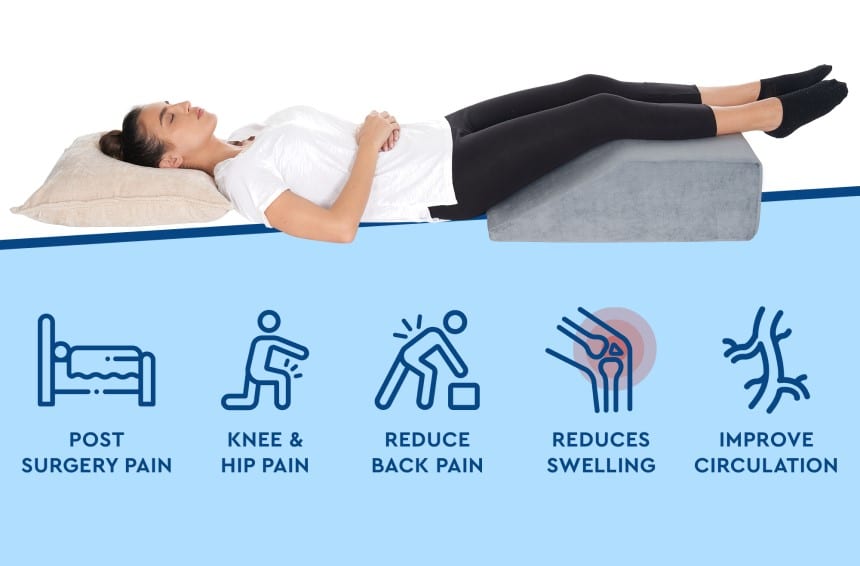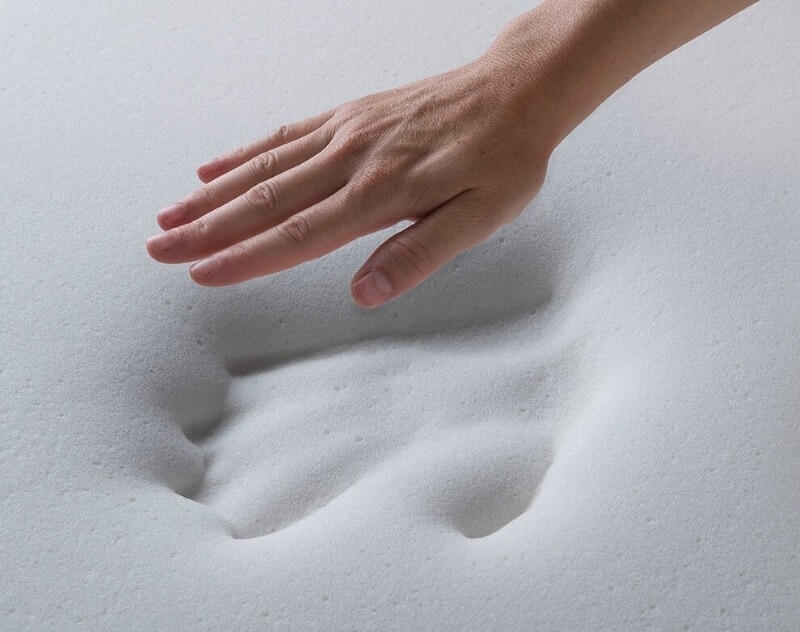

How many times have you been told by your doctor to sleep or rest with your legs elevated? Have you ever wondered why doing this would improve your health? Resting or sleeping with legs elevated is one way of allowing your body to heal and rejuvenate again.
It’s even more essential to sleep with legs and knees raised above your heart level after major surgery. This lowers the dangers of blood clots forming, the onset of edema and helps to improve poor blood circulation.
What is the best and most comfortable way to lie down with raised legs while sleeping? Read on to get all the answers to your question on how to keep feet elevated while sleeping. We’ll also talk more about the reasons for keeping your legs and knees raised when resting or laying down.

If you suffer from chronic back pain, sleeping with your legs and knees raised could help to alleviate the pain while you’re in bed.
One of the most common back pain problems is caused by the sciatica nerve. This nerve, which runs along the spinal cord, can cause extreme pain when inflamed or compressed. This results in the following symptoms:
By lying with your knees raised, you’ll be minimizing the symptoms associated with an inflamed or compressed sciatica nerve.
One of the threats many patients face after a major surgery is Deep Vein Thrombosis Trusted Source Deep vein thrombosis - Symptoms and causes - Mayo Clinic Deep vein thrombosis (DVT) occurs when a blood clot (thrombus) forms in one or more of the deep veins in your body, usually in your legs. www.mayoclinic.org (DVT). Poor blood circulation, injuries, infections, and genetic conditions can also cause DVT to develop. This condition is characterized by the development of blood clots in the larger veins and often begins in the lower parts of the legs.
A life-threatening condition, DVT becomes dangerous when the blood clot travels through the vein and reaches the lungs resulting in a pulmonary embolism. When DVT is diagnosed, your doctor will insist you raise your legs while lying down or seated. The legs need to be raised above the heart level to aid in improved blood circulation and to reduce the pain associated with this condition.
Sluggish blood circulation can result in you feeling tired and unwell while contributing to a number of health problems. To improve your blood flow, you can sleep with your legs and knees raised. This position helps gravity move blood around your body, from your feet to your heart without putting too much strain on your heart.
Blood flow from the lower regions of your body becomes oxygenated as it moves towards the heart. Elevating the legs and knees while sleeping improves the way the blood is filtered and circulated throughout the body, which is hugely beneficial for overall wellbeing.
Do you struggle with swollen ankles and legs? This condition, also known as edema, can be painful as fluids collect and build up in the tissues of your body. It most commonly occurs in the legs and the arms. Edema can be caused by standing for long hours on your feet or poor circulation as a result of other underlying health issues.
People suffering from edema have found great relief in raising their legs when resting or sleeping. While this won’t cure the problem, it certainly minimizes the level of pain experienced with this condition.
Do you spend many hours standing on your feet only to complain of swollen feet at the end of the day? This is a result of fluid build-up and poor circulation in the lower parts of your legs and feet. It can be painful and exhausting.
One of the ways to find relief from swollen feet is to raise your legs above your heart level. This action helps to alleviate the pain and to give your feet a well-deserved rest by draining tension from the lower extremities of your body. When pressure has been taken off your feet, the blood flow improves and you’ll feel rejuvenated.

This condition affects women more than men, and can also be caused by pregnancy, menopause, your genes and obesity. One of the best ways to alleviate the pain is to rest or sleep with your legs elevated. This allows your legs to rest while taking pressure off them, reducing the throbbing pain and swelling of varicose veins.
Raising your legs uses gravity to move the blood flow to the heart. This means there’s less strain on the heart pumping the blood around the body. Instead of having to use all its muscles to move blood up from the lower parts of your body, the heart can take advantage of gravity.
When recovering from any form of cardiovascular surgery, sleeping with elevated legs gives your heart the rest it needs while pumping blood. The less strain it takes while bringing blood from your feet and legs, the more chance your heart has to heal and recover.
If you’re asking is it bad to sleep with elevated feet, rest assured there are very few downsides to this sleeping position. The main problem with this sleeping position is if you’re not used to it, it may result in a restless and sleepless night.
Another problem with elevated legs during sleep could be the irritation of certain body contact points. However, this can be solved by using the right bed, mattress and pillows designed to improve your sleep with elevated feet.
Fortunately, innovative technology can be used to manage the way you sleep with your feet elevated. This prevents you from feeling uncomfortable while stopping any urge to toss and turn the whole night through while sleeping with feet higher than head level!
Adjustable beds are one of the best ways to sleep comfortably with your feet elevated. However, if you don’t have one of these in your bedroom, you could take advantage of incline pillows or even order a custom mattress.
Another option is a foam bed wedge system such as the Contour Products Backmax which allows you to design the best sleeping position for your medical condition. This system offers great orthopedic support while keeping you comfortable whether you’re seated or laying down.

The adjustable bed comes with a range of features including remote control to help you sleep comfortably in a number of positions including with elevated legs. When searching for the best adjustable beds make sure you factor in all the different features available.
Before adjustable beds became available, pillows or folded blankets were used to help keep your legs and knees raised. Today, you can still use this method especially if you’re on a tight budget and an adjustable bed is too expensive.
However, instead of struggling with layers of pillows or blankets, you can find an incline pillow, also known as a wedge pillow, designed specifically to aid with back problems, sciatica, and other health conditions.
When looking for the greatest incline pillows, take into consideration the following features:
Reviews of the Xtra-Comfort Bed Wedge Pillow talk about the benefit of this orthopedic support pillow made with memory foam material. And, it can be used behind the head, the back, or the legs to help alleviate many painful conditions.
If sciatica is your problem, laying down can be excruciating and finding the right sleep position is near impossible. But you’ll also find some of the best mattresses for sciatica nerve pain relief will aid in better sleeping positions for this painful condition.
Custom mattresses can also be used on an adjustable bed base to enhance sleeping with elevated legs. These can include memory foam mattresses designed to improve your sleep position, allowing your body to heal while you’re sleeping.

Some sleep experts recommend sleeping with a pillow between your knees to slightly elevate the legs and prevent pressure on your back. Side sleepers should also make sure they use a medium-firm mattress and an adjustable bed is also a great solution.
There are many benefits to sleeping with raised legs. You can improve the flow of blood without putting strain on your heart. Painful conditions brought on by blood clots, edema, and varicose veins can all be managed by sleeping with legs elevated.
Finding the most comfortable way to sleep when raising your feet above your heart level can be challenging but it’s possible with pillows, custom mattresses and adjustable beds. When looking at the pros and cons of sleeping with legs elevated, the positives far outweigh the negatives.
This is why you need to consider this sleeping position especially if you want to improve your general sense of wellbeing. You’ll be grateful when you wake up refreshed and ready to handle another day full of energy.





